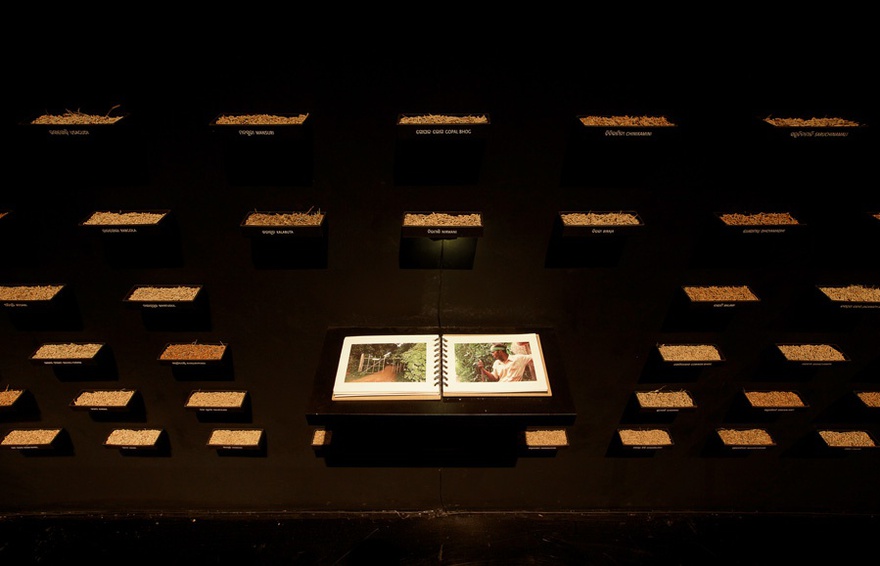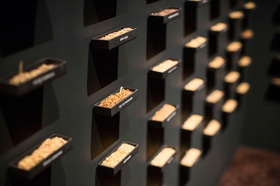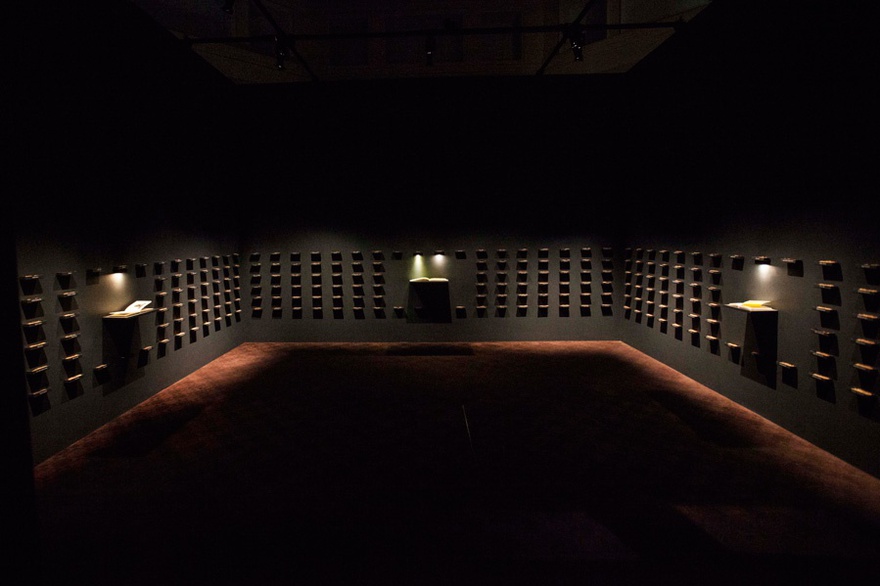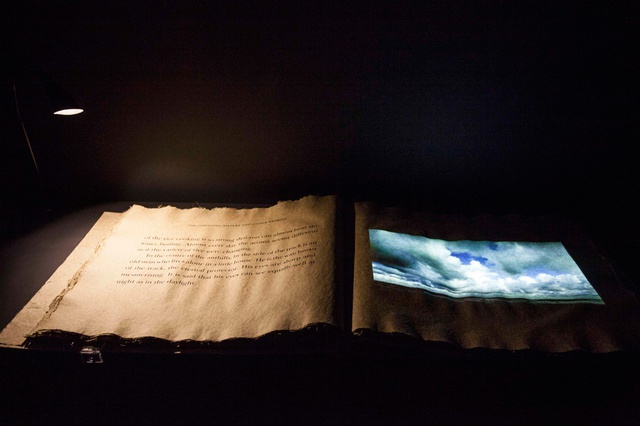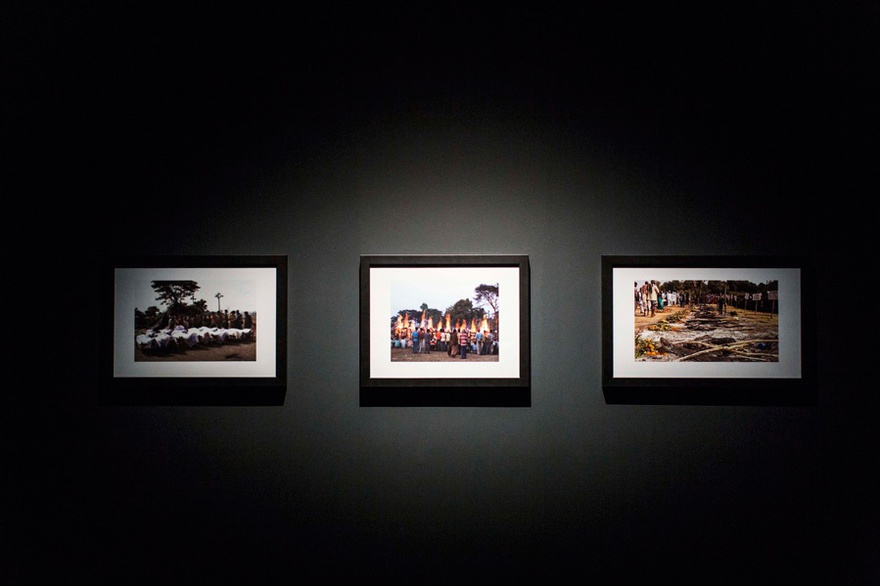Interviews
On Sovereignty
Amar Kanwar in conversation with Stephanie Bailey
Amar Kanwar's The Sovereign Forest (2011– ) is an ongoing project that is comprised of films, books, sculptures and photographs, presented partly as an archival installation that continues to expand and grow. The project portrays the exhaustive resistance movements that have responded to abuses of power in India, particularly in the region of Odisha (formerly Orissa), and has been presented in numerous contexts, including dOCUMENTA (13) (2012), the 11th Sharjah Biennial (2013), the Kochi-Muziris Biennale (2012–13), the Yorkshire Sculpture Park (2013–14) and most recently the 2014 Edinburgh Art Festival. With each iteration, new works are created and added, which build on the installation's focus and premise: a new addition in Yorkshire, for example, was a room with 157 photographs and documents – a selection from the Evidence Archive. This is a version of The Sovereign Forest that has been on permanent display at the Samadrusti campus in Bhubaneswar, Odisha, since 2012, in which materials relating to the imposition of industry on Odisha's predominately agricultural population are continuously added to the archive. Thinking about the way The Sovereign Forest considers notions of sovereignty, autonomy, as well as ideas around the commons, this interview explores the project in more global terms, while considering Kanwar's concerns as a documentarian.
Stephanie Bailey: Before we go into a discussion around The Sovereign Forest, I wanted to bring up a short film you made, Many Faces of Madness (2000), which is related to the impact of mining in India and its impact on rural communities. In one moment in the work, you come across drill holes and express a realization that these are markers of a community's demise. The work maps out the loss of autonomy over a region as natural resources are overtaken by industry. This is also one of the key themes in The Sovereign Forest.
Amar Kanwar: There are many other films that I made that get shown in different parts and ways, and also in different contexts. At the time I was working on Many Faces of Madness, I was working on an hour-long film called Freedom..! (2002), which was about a range of issues relating to natural resources and political resistances of different kinds. I was working with a very large non-profit, ecological and dairy cooperative and at a certain point – while I was in the middle of making that film – the Prime Minister of India visited them. In his schedule, there was a gap of 20 minutes, so I was requested to compile and make something from what I had filmed and addressed specifically at supposedly the most powerful man in the country. I did not want to make this film, but people said: 'What's the point? You have a chance to directly engage with the highest authority', and so on. In three weeks I managed to put it together essentially just to put a message across to this very high delegation – the Prime Minister and the bureaucrats – to see what they might say when confronted with this statement.
SB: And what statement was this?
AK: I could not offend anyone and yet had to say as much as was needed to be said, so it became a brief, high-speed glimpse into the ecological destruction that accompanied this industrial take over of the commons, put together from various parts of the country. This corporate land-grab and take-over had the approval of governments and was being marketed as a great national project for the benefit of all. Anyone educated who opposed it was branded anti-development, anti-growth and therefore anti-national. Any rural, formally uneducated person was branded illiterate/unaware or misguided, as if they did not have intellectual capabilities. My interest was to see how these powerful leaders would react, if at all, when they saw a spectrum of ecological destruction as well. What was eventually interesting was their official and private responses, one said we have already sold the country and its too late to talk now, the other kept silent and the third said I agree and will work with you. And so on. So within a system, one was able to connect in some way with varied levels of discomfort but was also confronted with the possible irrelevance of hope.
SB: This relates to the question that you pose in The Sovereign Forest: about how an artist might become a witness to the role of the state and its collusion with corporations, as well as the impact of such collusions on local ecologies and, by extension, communities.
In one interview, you talk about the massacres of Sikh residents in Delhi immediately after the assassination of Indira Gandhi in 1984, and you also talk about the Union Carbide explosion and gas leak in Bhopal, which occured that same year. Both events marked the point you first became interested in, or reacted towards, the role of the state in events such as those in 1984. This really comes to a head in The Sovereign Forest, through which you look at the land as a primal, material space of evidence; a space of contention and dissonance when thinking about the tensions and struggles that take place between the people and the state. Could you expand on this?
AK: It is interesting that you make this connection. Following Indira Gandhi's assassination in October 1984, over 3,000 Sikhs were killed in my own city in Delhi and more in other parts of the country; the police did not stop the killings for a few days. This was directly and indirectly managed, allowed to happen by the political party in power as well as other political groups. When the Union Carbide gas leak happened, almost a month later, you had exactly the same situation but in a totally different context. In both these situations, the state was actually involved, complicit or responsible for the killings, in one way or another and in both cases the state has continued to protect those responsible even to this day, more than 25 years later. Even if you pick up the newspapers this morning, you can still find references to the state and its various representatives actually protecting those responsible for 1984.
With respect to The Sovereign Forest what you are saying is connected. We cannot simply accept the 'good intentions' of the state anymore and the frameworks that it chooses to operate in. The state is continuously reinventing and presenting its rationale for usurping all power and in the process all basic understandings become reversed, nullified and meaningless. Facts become fiction, deception is advertised, multiple forms of violence take place and it seems we become unable to find a way to identify or comprehend what is valuable, what is needed, what is gained or lost. Territory is central to sovereignty. As well as what lies under it and over it. So I thought, 'let's begin with that'. As you say, I do 'document' the land in a way, but I have searched for different method to look at it. The Sovereign Forest contests this confirmed, guaranteed, eternal ownership and in many cases, this fascist and totalitarian sovereignty. It begins to do this process of questioning from multiple positions of looking, experiencing, story-telling and comprehension.
It is asking for a re-understanding of the question of sovereignty and wants to open these discussions on every specific incident and also in the context of sovereignty. Of course, there's a lot more to this: there are several dimensions within the question of sovereignty and there are many sections that I have worked on, researched and identified in terms of how we get into the condition of sovereignty. But to address the questions you have raised, we must question the implicit so-called ownership of the state over land and so on.
SB: This relates to The Sovereign Forest as the literal scene of a crime –- and you also include a work in this installation The Scene of Crime (2010), which maps out the land of Odisha in its minute detail, so as to document aspects of it that are in demise, since they have been given over to industrial interests by the state. Also included in The Sovereign Forest installation is The Prediction (1991–2012), in which you document civil movements against corporate encroachment in Chhattisgarh, another region-rich area of India right next door to Odisha through the assassination of the civil movement's leader, Shankar Guha Niyogi (apparently at the hands of leading industrialists who were convicted by the trial court before being acquitted by the high court), who predicted his own death. Niyogi's assasination recalls that of Gandhi's, but is also calls into question the lives of farmers who committed suicide as a result of the imposition of corporate control over local lands in Odisha and in Chhattisgarh, which you also document in The Sovereign Forest. This raises the issue of whether these deaths were indeed suicides or if they constituted murders, or indeed assassinations, by the state and its apparatus.
AK: Absolutely correct. I wish more people would work it out like that. I am linking these and several other assassinations over a long period of time, and in many ways questioning democracy, questioning sovereignty and that is why, in a way, there's a significant next step that The Sovereign Forest has to take. At the moment it has visually become apparent, it has made a case, but it needs to push these propositions and assertions to another level and that's what I hope to do over the next couple of years.
SB: This is interesting in thinking that the Yorkshire Sculpture Park iteration of The Sovereign Forest staged in 2013–14. In the main area of this exhibition, you created a charged space that essentially produced a figurative 'sovereign forest' within the space itself: a common space of sorts. It was in Yorkshire that you also presented for the first time evidence accumulated over one year in the permanent installation of The Sovereign Forest in Odisha, which opened on 15 August 2012 at the Samadrusti campus in Bhubaneswar, and which continues to collect material related to local struggles. Through its documentation, and through its dual iteration as a moving exhibition and a local archive assembled by those who live in and around Odisha, The Sovereign Forest project ultimately raises global questions around the role of the commons today – of collective ownership and management of land and resources. I think these are questions that you have been asking in your work, not just through The Sovereign Forest but in The Torn First Pages (2004–2008) and 7 Films on the Commons (2011), for instance. Ultimately, the themes you investigate are global as much as they are local, because they focus on agency in local communities and their dealings with state and capital.
AK: Yes. There are many points you are touching upon here, and I will try to give a spectrum of responses. First and just to tangentially for a moment get into the question of documentary and documenting. The definition of the 'document' in the documentary has for long been tossed up in the air. Sometimes, I like to ask, essentially to open up the discussion – how would you document a fantasy and how would you document reality? And hypothetically, therefore, would you have a different language for documenting fantasy and a different language for documenting reality or would you say that it's not possible to 'document' fantasy? If I were to document fantasy then would you want to categorize it in another way? I'm always asking 'what's more real? If somebody wanted to know the "real" me, what would be more real, would it be – my facts or my dreams?' I think we have painted ourselves into a corner with this documentary term and actually need to free ourselves from this corner and perhaps from any corner. The whole question of documenting and the categorization of what documentation means needs to be relooked at, even if temporarily.
SB: This is something you explore in The Scene of the Crime...
AK: As far as The Scene of the Crime is concerned, and the question of poetry and evidence, art and agency and so on, in a sense it's quite straightforward. The frameworks and methods available or given to us to comprehend what is around us do not seem to work, for me at least.
Central to the notion of 'crime' is the question of evidence. When you look at any crime, it is investigated by an agency, which is the police or the criminal justice system of any society. Subsequently only evidence, which is defined as permissible by the law, is allowed to be presented in court – all other evidence is dismissed as invalid. The carefully crafted text of the law tells us what is permissible and then how to understand and therefore what to conclude.
But what happens if a crime continues to occur regardless of the enormous evidence available? Then is the crime invisible or the evidence invisible or are both visible but not seen? The moment you ask this question a new set of questions emerge. What is the scene of crime, what is its footprint? Is the crime always a single cataclysmic event or is it also something that expands and is an accumulating process? And finally which vocabulary has more capability to understand the scale and extent of a crime? If I do not understand the meaning of loss, its scale, its extent, its multiple dimensions then how could I even know what it is that is lost?
I do not intend to denythe value of forensic investigation, in fact I am requesting for a dynamic relationship alongside it and outside the limits of a factual ontology with a hope to reconfigure the question of evidence and therefore perhaps of all comprehension. There was a time when the testimony, even in flux and ever changing – the anecdote with its insights, the experience with its unprinted wisdom – was all central to the exploration and expression of truth. Everything else was added on to that knowledge. In essence, The Sovereign Forest attempts to bring the non-forensic back to the centre of discourse, and the only way to do this was/is to experiment with ways of seeing, showing, perceiving – the opening up of and a dialogue within a multiplicity of senses. And so, therefore, there are a cluster of questions: Who defines evidence? Is legally valid evidence adequate to understand the meaning and extent of a crime? What is the vocabulary of a language that can talk about a series of simultaneous disappearances occurring across multiple dimensions of our lives? And so I am asking, in a sense, for permission – can I be allowed 'officially/formally' to present poetry as 'evidence' in a criminal or political trial? The Sovereign Forest – not metaphorically and not esoterically but formally, clearly and with reference to specific crimes – presents in the public space, poetry as evidence in its multiple forms. And it requests you to see, evaluate and compare the nature of comprehension, understanding of the scale, meaning and implications of the crime.
The second related point is that the way you look at the scene of a crime is significant. So while working on the film and while making the film in terms of methodology of filming and the methodology of research and so on, I worked for quite some time on trying to work out a certain way of looking that would put you into a certain position and create a certain experience of looking. In the end, when coupled with this constellation of evidence in multiple forms, it is possible for you to actually move within and between various parts of a much larger whole. You can then experience the inner relationship and multiple dialogues between these various parts, but how in the first place do you get to that inner relationship? I felt that if you were to look in a certain way you would comprehend in a certain way and if you were to comprehend in a certain way it could be the route to a certain type of compassion.
Thirdly, if I make a film called The Scene of Crime and took The Scene of Crime to the scene of the crime, what would happen? My supposition was that if I took The Scene of Crime to the scene of the crime, those who live in the scene of the crime are likely to say, 'thank you, it is a sensitive and beautiful and perhaps even unique insight you have created about what we are experiencing however its not enough, there is far more to understand, because only we know what it really means, to live in the scene of crime'. It is this inadequacy that I am interested in; it is the collective response to this inadequacy that I was interested in, that we have to eventually deal with. The moment we identify this inadequacy we are all compelled, driven, required to respond to it. And we will respond in varied ways. Sometimes with more evidence, more forms of interpretation and also possibly a new unfolding narrative of the contemporary. And then another memory may begin to emerge. So The Sovereign Forest eventually became a constellation of evidence that circulated around The Scene of Crime. Now, when you present The Scene of Crime in the scene of the crime and when more evidence gets collected, we are all faced with a dilemma – what do we do with this evidence? Where do we keep it? How to relate to it? Then we have to protect it. And so everybody who is part of the process – collaborating, working, involved, engaged – everybody has to find a space and a method to be able to actually present this evidence, and the moment you have to find a space we actually become an art space, and the moment we become an art space we are totally confused because is this an art space, or is this a public trial?
SB: This goes back to the disclaimer in the books you have produced as part of The Sovereign Forest, in which you acknowledge all of the people who have added to this archive. This highlights the fact that the project as a whole, The Sovereign Forest, is a constellation – or accumulation – of material that is almost authorless, which relates to the constellation of evidence you present, such as through the seed bank, which is probably one of the most literal ways of looking at how you deal with evidence through accumulation. What is revealed here is the process of negotiation, in that the project relies on the testmonies and submissions of others.
AK: Yes, in many ways there are negotiations and inner relationships always at play. There is a part that has an author but subsequently this author grows only with other authors. The Sovereign Forest is eventually multi-collaborative – after a while it's hard to find which route begins where. Like in a forest, I suppose. There are friends who are artists who are activists who are authors and they are known, but there are several others who are not that visible. The multiple seed varieties of rice presented as evidence in the constellation of The Sovereign Forest may seem at one level quite literal, but in essence they are containers of several generations of a fluid intangible knowledge system developed by farmers. Authors, actually.
SB: And this brings in the other side of the narrative, which was expressed in maps that you had included in The Prediction – including minerals and resource maps of Odisha. This illustrates this carving up of the land through its resources that is happening in Odisha and beyond, through the many memorandums of understanding between such multi-national companies as POSCO and the state government.
AK: If you were to administratively demarcate territories, then you get the state of Odisha and you get the state of Chhattisgarh, just like you would get in England or anywhere. But if you were to understand the land geologically and geographically then your markers are very different usually – they are a ridge, a hill range, or a river. The territory that The Prediction is in reference to is a state adjacent to Odisha but geologically it is the same terrain: it is the same seams, the same rivers, the same forests, hill ranges and so on. With The Prediction, I wanted to present a reference of an older scene of crime that went through the legal system whilst the rest of The Sovereign Forest is a contemporary unfolding crime. The Prediction was about a crime that happened more than 20 years ago, that went through the formal trial of the lower courts and high courts and supreme court and in a way it's a done and dusted, closed case. There are two predictions in The Prediction: one is that Niyogi predicted his own assassination; and the second prediction was the reason for his assassination – that there is a severe onslaught about to begin on the forests, minerals and the regions as a whole and that in order to enter the area and have free access to the minerals they needed to eliminate this very large democratic opposition and their leader.
With respect to the issue of the maps, it's as old as when the British were here, which is that if you were to take a map of India, and a mineral map of India, and then a forest map, and a map of the indigenous communities and then overlapped all these you would realize that they are all concentrated in the same areas. And now you will find that in the last 20–25 years, ever since global policies changed and these minerals became accessible, you would find a large concentration of cultural initiatives by different local and international governments in these mining areas. You will find musicians and teachers from these areas being sponsored. Human rights funding, conflict resolution programmes and so on. So in a way, another map could be added here as well. The same people plan the land-grab and plan the conflict resolution as well.
SB: It makes total sense, because what I was leading towards was this essay by Suniti Kumar Ghosh about Marx's reading of India in the 1850s and how it changed in later decades as he became more disillusioned with capitalism as a productive social force, observing how it had, in India, produced a new and international division of labour suited to the requirements of the chief centres of modern industry. For Marx, the railways in India allowed for an immense impulse to the development of foreign commerce, but mainly for the export of raw produce, which, and I quote, 'increased the misery of the masses'. This relates very much to Odisha, when thinking about a corporation like POSCO, a multi-national steel making company, and its presence here and effect on the community, but it also relates all the way back to the East India Trading Company and this history of colonialism as mediated through trade and commerce…
AK: Yes you should see the miles and miles of cargo trains and dumper trucks carrying ore out! So let's discuss who owns this, who decides and why and what does sovereignty mean? Who has access to it and who doesn't?
SB: Yes and again it's a kind of conflict between industry and nature. As you said, Odisha is an agricultural society, which relates to the view Marx had in the late nineteenth century of a restructuring of global society so that some societies became spaces for raw materials or primary resources, such as India, for the industrial nations, such as Britain. So you had this kind of global industrial layering, or division.
AK: Yes. And we are just seeing a rerun of that, but it has shifted. When you are looking at these hills in Odisha, and you learn about what minerals they contain, you will see that Odisha actually has the largest remaining bauxite reserves available anywhere in the world. What that actually means is that bauxite in places like South America has already been taken, and so industry has shifted and has found new places to extract what they need. And if you really trace this back, then you can see that in all these areas in Odisha, the extractive investigations into the land and what was beneath it by international corporations began more than 20–25 years ago.
There is enough contemporary evidence to show that they have been preparing for this: that they actually calculated the years it would take to enter and access these minerals in Odisha. You have banks, for example, that now give industries insurance for delays caused by resistance within communities. These corporations know that when they come in to a region, of course they will face not only resistance by the local communities, but red tape and local policies. They know it will take a certain period of time to change policy in a nation – you need to cultivate a political class; you need to corrupt a bureaucracy; you need to influence parliament; you need to systematically manipulate and offer a whole set of things. This process can take years. However, you are likely to run into local resistance on the ground and these resistances can delay things even further, which will of course incur losses. So these corporations are compensated for this: they are insured for these losses, but up to a point. When it crosses over the time period of viable delay they have to start withdrawing or increasing compensation or increasing repression on local populations.
This is a familiar paradigm, local communities or resisting populations/individuals are termed as illiterate, anti-growth, anti-development and therefore by extension anti-national. The reverse is that if you do not oppose corporations you become patriotic.
SB: This question of sovereignty is something of a zeitgeist issue given how infrastructures around the world have been collapsing under the weight of the global economy, not to mention how the global economy is producing shifts in infrastructure...
AK: I do say that The Sovereign Forest is actually about institutions – of finding ways to create institution's that are processes, that are intangible yet consistent, that have the ability to change, and is comfortable with collapsing as well – in a way, how a fragile temporary process can actually become strong, evolving and capable. If I was to explain to you how The Sovereign Forest came about, or explain what is happening in The Sovereign Forest locally, I would actually not talk about anything that was in the installation and I would talk about a whole lot of things that have been and are actually happening behind it, around it, connected to it, which are actually very institutional in that sense. The Sovereign Forest is actually also talking about institutions that can change from one form to another.
SB: Yes. And as an installation, a project, and an archive, The Sovereign Forest is so much about envisioning networks within a space: both the space of the exhibition, the space of the art world, and the regional space of Odisha and its districts...
AK: An obvious next step for The Sovereign Forest is actually to go into rural common property areas, though we don't know how to do that so we have to figure it out. Of course to do that we have to also find money. I have to sit down with Sudhir Pattnaik and Sherna Dastur – the two people that I have collaborated with in the making of The Sovereign Forest and worked with for all these years and who have been critical to this installation – and see what is viable and feasible. We do get varied propositions: people are asking and are giving us locations and venues to show the project. Some have money and some don't. Some have land, buildings, community property but no other resources. To take it to areas within different communities or in rural spaces, we need money even if we do find a location or common land. So the future is there up ahead: we just have to try and take steps in the right direction and see where that leads us.
Amar Kanwar is an artist and filmmaker whose poetic documentaries and video installations examine nationalism, politics, violence and social performance in the Indian subcontinent. Kanwar's films are complex contemporary narratives that connect intimate personal spheres to larger social and political processes, linking legends and ritual objects to new symbols and public events, mapping contexts and exploring the politics of violence, power, sexuality and justice. Kanwar's films have been screened in local and international film festivals, galleries and museums, and he has had solo exhibitions at the Yorkshire Sculpture Park, UK (2013–14), Fotomuseum Winterthur, Switzerland (2012); Stedelijk Museum, Amsterdam, the Netherlands (2008); Haus der Kunst, Munich, Germany (2008); and Whitechapel Gallery, London, UK (2007), among other venues. He participated in Documenta in Kassel, Germany, in 2002, 2007 and 2012. He was also the recipient of the first Edvard Munch Award for Contemporary Art from Norway. He lives and works in New Delhi.

